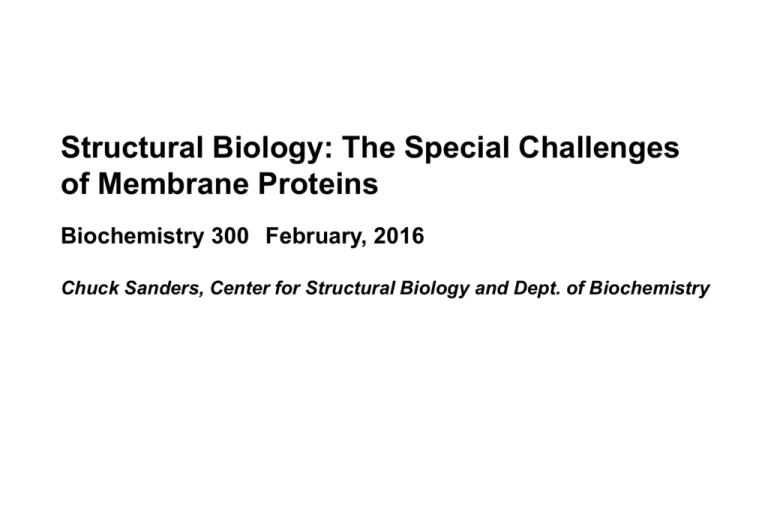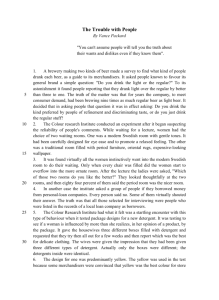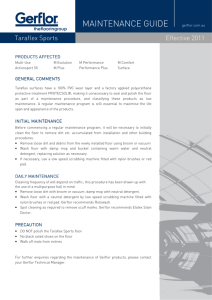Detergent micelles… - Center for Structural Biology
advertisement

Structural Biology: The Special Challenges
of Membrane Proteins
Biochemistry 300 February, 2016
Chuck Sanders, Center for Structural Biology and Dept. of Biochemistry
There are two general classes of
membrane proteins. This presentation is
working with integral MPs.
Multilamellar Vesicles:
Onion-like assemblies.
Each layer is one bilayer;
a thin layer of water
separates bilayers.
Unilamellar
Vesicle
Multilamellar
Vesicle
Energy from sonication, physical
manipulation (such as extrusion), or
some other mechanism is required
to convert multilayered bilayer
assemblies into unilamellar
vesicles.
The Simplest Membrane is Represented by a Bilayered
Unilamellar Lipid Vesicle (ULV), Also Known as Liposome
Bilayers can undergo phase transitions at a critical temperature,
Tm. The Tm for the lipid most commonly used for bicelles, DMPC,
is 24.5ºC.
Phase
transition as
temperature
is raised
up through
Tm.
A.K.A.:
“Fluid Phase”
Gel Phase
Liquid
Crystalline
Phase (L)
Bilayer Dimensions: Lewis and Engelman, JMB 1983
DMPC Tm= 24 deg. At 36 deg:
Phosphate to Phosphate: 3.4 nm
(34 angstroms)
Hydrophobic Thickness: 2.3 nm
Surface area: 66 square angstroms
DPPC Tm = 41 deg. At 44 deg:
Phosphate to phosphate: 3.7 nm
Hydrophobic Thickness: 2.6 nm
Surface area: 67 square angstroms
DOPC Tm = -14 deg. At 20 deg.
Phosphate to phosphate: 3.8 nm
Hydrophobic thickness: 2.7 nm
Surface area: 70 square angstroms
EYPC (mostly POPC)
Hydrophobic thickness: 2.8 nm
E. coli lipids
Phosphate to phosphate: ca. 4.2 nm
Tm is the gel to fluid phase transition.
Fluid phase (above Tm) is the physiologically relevant phase in most cases.
Micelles as Models for Membrane Bilayers
Micelles
Bilayer
Vesicles
Lipid Bilayers are typically 25-35 angstroms thick (hydrocarbon
domain) or 35-45 angstroms (polar headgroup to headgroup).
The largest micelles are much smaller than the smallest lipid vesicles. Micelles
are water soluble. Lipid vesicles are, at best, only marginally soluble and can
usually be pelleted by centrifugation.
Lipid:
Cylinder Shape
Usually 2 acyl/alkyl
Chains, at least
12 carbons each
(in humans, usually
16-18 carbon chains)
Detergent:
Usually Idealized as
Conical in Shape
2 short (6-8 carbons)
Unsaturated acyl
chains, or 1 alkyl/acyl
Chain (8-14 carbons).
Micro- to millimolar
monomer solubility
in water.
Transmembrane
Helix
Diameter of cylinder is
similar to that of a typical
lipid, but twice as long.
Beta-octylglucoside
Examples of
Classical Detergents
Dodecylsulfate (SDS)
Beta-dodecylmaltoside
Not all detergents are
shaped like ice cream
cones.
O
NH
OH
OH
OH CHAPS+
N
+
SO3
OH
CHAPSO
CHAPSO Bile salt-based
detergents (Janus-like)
Triton X-100
Detergent micelles…
typically:
only a few nm in
diameter
aggregate MW <100 kDa
fully water soluble.
hydrophobic tail
polar
head group
monomer
micelle
Increasing Total Detergent Concentration
When [Total Detergent] < CMC :
Free Detergent Only
When [Total Detergent] > CMC :
[Free Detergent] = CMC and
all additional detergent goes into
micelles. As additional detergent
is added, all of it goes into micelles.
Detergents: Vital Information
Detergent Critical Micelle Concentration (CMC):
•When [total detergent concentration] is below CMC, all detergent
molecules are monomeric (free) in solution.
•When [total detergent concentration] is greater than CMC there is a
monomeric detergent concentration equal to [CMC]
•Above CMC there is a micellar detergent concentration equal to:
[total detergent concentration – CMC]
Examples:
β-Octyl glucoside
Sodium dodecyl sulfate
Decyl maltoside
Dodecyl maltoside
Triton X-100
DHPC (D6PC)
DHePC (D7PC)
25 mM
7 mM
2 mM
0.2 mM
0.25 mM
14 mM
1.5 mM
The lower the CMC, the harder
It is to get rid of the detergent.
If CMC is high, it means you
need a LOT of detergent to
do anything ($$$).
Detergents: Vital Information
Aggregation Number =
the average number of detergent molecules in a single micelle.
Concentration of micelles = {total detergent conc. – CMC} ÷ aggregation #
Aggregate Molecular Weight of Micelle =
Aggregation number x detergent monomer molecular weight
Typical aggregation numbers: 50-200
Typical aggregate MWs: 20-100 kDa
Do not memorize!
For reference purposes. Do not memorize!
Extraction of Membrane Proteins from Bilayers
Protein-Detergent-Lipid
Mixed Micelle
Membrane Protein in Bilayer
Addition of detergent
above CMC and at a
high detergent:lipid
ratio
C
C
From a membrane protein’s point of view, some detergents
tend to be “harsh” in that they partially or fully denature the
protein.
Other detergents are “mild” in that they tend to solubilize
membrane proteins in a way which maintains their native
function.
In general, non-ionic (uncharged) detergents tend to be the
mildest, followed by zwitterionic detergents (charged, but net
charge of zero), followed by detergents which have a net
positive or negative charge (most harsh). For example,
dodecylsulfate is harsh, while dodecylmaltoside is mild.
Harsh detergents to use for
“universal extraction” (inclusion bodies, etc.):
SDS
advantages: will solubilize everything for sure
makes subsequent SDS-PAGE easy, pure/cheap
disadvantages: finicky, may sometimes
not work well with Ni(II)-agarose resin, anionic
Lauroyl Sarkosine: C11-CO-N(CH3)-CH2-COOadvantage: not a finicky as SDS, pure/cheap,
disadvantages: anionic, not as strong a denaturant as SDS
+
-
Empigen: C12-N(CH3)2 -CH2-COO
advantages: fully compatible with use of
Ni(II)-agarose, zwitterionic
disadvantages: impure form cheap, but pure
Use of hexaHis
tags in manipulation
of membrane protein
host medium.
E. Coli Harboring
Overexpressed
polyHis-tagged DAGK
Harvest and Lyse
Extract with 3% Empigen
C
Apply to Ni-Agarose
121
TM1
Wash with 40 mM Imidazole
+ Empigen
D
46
Pure DAGK Bound
to Ni-Agarose
Membrane
7
(5-30 mg/ml)
DAGK
in
Bicelles
DAGK
in
Mixed
Micelles
N
32
F I A 14
L
A 24
20 G
G
T
R A
T
K A
T
K 15
N
8
R W I N
W
I
G
N
22
S
25
11
A
Y16
1
DAGK
in
Liposomes
C
V
39
Elute with Detergent
Solution of Choice and
250 mM imidazole
DAGK in Micelles
50
L
W
I
L
V D A
L 48
A
A
R
45
28
Cytoplasm
I
V
L
V 42
V
A
V
G
Q E
R
F
A
A 30
E
53
35
G
F H S
T
L
L
56
112
W
T
TM3
118
W
I
L
C
I
I S
V
A
S 61
V
I
105 I
M L 64
A
I
V M
L
V
I V
A
E
98 S
A
68
I L
G
N S
M
94 K
72
A I
D
A
G
E A
R
S
V
91
L
V D
E
79
R I
88
H
G S
E
Y
83
V
TM2
TM2
TM2 TM2
C
Cross-section of detergent/membrane protein complex. The detergent forms a
torus (ring) around the hydrophobic transmembrane domain of the protein, leaving
the polar extramembrane domains of the protein exposed to water.
Detergent Concentration Following IMAC Purification of a
Membrane Protein
Total detergent = [CMC] + [free micellar] + [protein-associated]
If you equilibrate of membrane protein associated with
a chromatographic resin with a 0.5% solution of detergent
and then elute that protein, the final total detergent concentration
will be 0.5% plus the amount of detergent which is associated
with the protein.
This needs more
study.
As a very rough guess, you can assume that the
membrane-associating domain of a membrane protein binds twice
its weight in detergent and/or lipid. (For DAGK, e.g., we know it
binds twice its weight in detergent).
So, if you have a 1 mg/ml solution of a MP that has 50% of its
sequence involved in membrane interactions, you could guess that
the solution would also contain 1 mg/ml of protein-associated detergent.
Surface Dilution
Same bulk concentration of
red molecule on left as on right
of vertical line, but 3X as
concentrated within the micelle
bicelle or vesicle.
Surface Concentration:
Usually Mol fraction or Mol% Units
Mol fraction for “A” =
{moles of A in the membrane} ÷ {total moles of A + other components of the membrane}
For example: 1 mM C99 in 100 mM LMPG micelles is a 1 mol% C99 solution, whereas
1 mM C99 C99 in 200 mM LMPG micelles is a 0.5% C99 solution.
How to transfer a purified membrane in detergent micelles back into lipid vesicles?
Free and Micelle-Associated Detergent is in Rapid Exchange
Protein-Free
Micelle
Protein-Detergent
Mixed Micelle
Rapid
Exchange
Rapid
Exchange
C
Free Detergent
concentration = CMC
Membrane Reconstitution: Taking purified membrane
protein(s) in micelles or mixed micelles and transferring
them back into membrane bilayers. If successful, protein
will function properly in the resulting bilayered lipid vesicles
(liposomes).
Most common methods:
(1) Selectively remove detergent from protein/lipid/detergent
mixed micelles using dialysis, size exclusion chromatography or
some other method. Protein/lipid bilayered vesicles form
spontaneously as detergent is removed.
(2) Dilute protein/lipid/detergent mixed micelles to below the
detergent’s CMC.
(3) Selective binding of detergent to hydrophobic beads leaving
protein behind with lipid (sometimes results in denaturation of the
membrane protein).
Membrane Protein
Purification and
Reconstitution
Methods for Detergent "Removal":
• dilution to below CMC
• size exclusion chromatography
• dialysis
• use of "Bio-Beads"
(detergent adsoptive resin)
Example of a Membrane Reconstitution Protocol
E. Coli Harboring
Overexpressed DAGK
DAGK in DPC
Micelles
(still misfolded)
(Jim Bowie, UCLA)
Extract with Detergent
Apply to Ni-Agarose
Elute with DPC
and 0.3 M imidazole
Wash with 40 mM Imidazole
+ Detergent
1. Add DPC/POPC Mixture
2. Dialyze out DPC
Equilibrate with Elution
Detergent
Pure DAGK Bound
to Ni-Agarose
DAGK in
POPC
Vesicles
(Refolded)
Redissolve
in detergent
micelles
DAGK in
Mixed
Micelles
(Still Refolded)
Mixed micelles also contain lipid in addition to detergent. Usually
The detergent-to-lipid ratio is in the range of 1:20 to 1:5. Usually,
the lipid is a phospholipid (often PC), but sometimes you might
want a cholesterol mimic.
Cholesterol: low solubility in micelles
Detergent-Lipid Mixed Micelles
Cholesterol hemisuccinate: modest solubility in micelles
CHOBIMALT: water soluble
Other Model Membranes Besides Vesicles, Micelles,
and Mixed Micelles.
O
Bicelles
Combine some advantages
of micelles and bilayers as
a medium for membrane proteins
O
O
P
O - O
O
O
+
N
O
O
membrane proteins have been
crystallized from bicelles
+
N
O
O
P
O O
O
O
DHPC
O
Tm for DMPC is 24.5 deg. C. Bestcharacterized 5-20 deg. C above Tm.
NH
OH
DHPC-DMPC seems to work
better for solution NMR.
DMPC
O
OH
N
+
SO3
OH
CHAPSO
OH
CHAPSO-DMPC seems to work
best for X-ray crystallography
(even GPCRs).
Both systems work well for
solid state NMR.
If a negative charge is desired
can use DMPG to replace part
of the DMPC.
20-40 nm
4 nm
Intermediate Structures in Membrane Dissolution by Detergents
Increased
Detergent
q = moles lipid
to moles detergent
Detergent-Free
Bilayer
Perforated
Bilayers
Tape/Worm-like
Bilayered Strands
Membrane Permeabilization By Relatively
Low Detergent Concentrations.
Idealized Intermediate
Between Sheets and
Monodisperse Assemblies
(probably metastable)
Classical Bicelles:
Bilayered Discs
Classical
Mixed Micelles
q = 0.5 means
1:2 lipid to detergent
= 0.33 mol fraction
lipid
The size of bicelles is
determined
by the detergent-to-lipid
ratio. The higher the
detergent the smaller
the bilayered discs.
Membrane Fragmentation to Form Bicelles at
Somewhat Higher Detergent Concentrations
(typically 4:1 lipid:detergent to 1:1 lipid:detergent)
Intermediate Structures in Membrane Dissolution by Detergents
Above Tm for the lipid
(24.5 deg. C for DMPC)
this phase persists from
q = 2-5 for DMPC/DHPC
or q = 3-8 for DMPC/CHAPSO
Membrane fragmentation to
form bicelles at somewhat
higher detergent concentrations.
Above Tm this phase likely persists
q = 0.25 to 1.0 for DMPC/DHPC.
note: “isotropic” means
small bicelles
“bicelles” in this plot means
magnetically-alignable bicelles
Under the low q conditions of
solution NMR (DMPC < 50%),
we are in the isotropic phase
at all temperatures.
(increasing DHPC )
“Large bicelles” can magnetically aligned. However, it is now
realized that it is probably not the ideal bilayered discs that
align, rub rather the “Swiss cheese” bicelles that form at
more lipid-rich detergent-to-lipid ratios.
No
Magnetic
Field
With
Magnetic
Field
As for lysophospholipids, you have to be concerned about
hydrolysis of the ester linkages in bicelle lipids and detergents:
***Work as close to neutral pH as possible (6.0 – 7.8 should be OK)
***Always include a little EDTA (0.5 mM) in bicelle solutions to
scavenge any free multivalent metal ions, which can be potent
hydrolytic catalysts.
Solution NMR studies are usually
Carried out using q = 0.3-0.5.
Nanodiscs
Originally Developed by Steve Sligar, U. of Illinois. There now many variations.
http://www.nanodiscinc.com/
Key: 200 residue protein that
is a series of linked amphipathic
helices. Expressed in E. coli.
Expression vectors now
commercially available.
Unlike bicelles and micelles, nanodiscs persist even at very high dilution. A great property for EM.
J Am Chem Soc. 2013 Feb 6;135(5):1919-25.
Optimized phospholipid bilayer nanodiscs
facilitate high-resolution structure
determination of membrane proteins.
Hagn F1, Etzkorn M, Raschle T, Wagner G.
SMA Polymers
and
“Lipodisqs”
“Amphipols”: Amphipathic Polymers
First developed by Jean-Luc Popot and Co-Workers at CNRS
Soluble Membane
Protein Complex
With Amphipol
A8-35
C
Randomly derivatized amphipol (above).
In this case there two types of side chains
and the polar:apolar side chain ratio is
near 1:1.
Amphipols differ from SMA polymers in that they are NOT good at solubilizing lipid.
Unlike micelles, amphipol/MP assemblies are stable even a very high dilution.
Exotic Membrane Phases
Annual Reviews
Lipidic Cubic Phase
(used as a crystallization medium)
Much of the recent work
has been done by Martin
Caffrey and Vadim Cherezov
Cartoon representation of the events proposed to take place during the crystallization of an integral
membrane protein from the lipid cubic mesophase. The process begins with the protein reconstituted ...
Caffrey
Volume 71 | Part 1 | January 2015 | Pages 3–18 | 10.1107/S2053230X14026843
Bolaamphiphile
Bolaamphiphile
C
Conventional
Detergents
Lipopeptides as Model Membranes
Developed by Gil Prive. U of Toronto
Amphipathic
lipopeptide (left)
and cross-section
slice of complex
between lipopeptide
and IMP (right)
C
Crystallization of IMPs
See “A Pedestrian Guide to Membrane Protein Crystrallization”
Michael Wiener; Methods 34, 364-372 (2004)
crystal contacts are usually
protein-protein in nature, but
not always
Most crystal structures involved
micelle conditions. However, it is
getting increasingly common to
see structures where the lipid cubic
phase, bicelles, or mixed micelles
were used.
NobelPrize.org
Biochemical Society Transactions (2011) 39, 725-732 - Martin Caffrey
www.biochemsoctrans.org
2-D Crystallization (for EM or AFM)
2-D crystals of membrane proteins
can sometimes be grown and then
subjected to “electron crystallography
using EM equipment, sometimes leading
that leads to a high resolution structure.
Rigaud JL.
Braz J Med Biol Res. 2002 Jul;35(7):753-66.
Negative Stain EM: Staining/dilution/drying may wreak havoc on some model
membrane systems– especially micelles and bicelles
Cryo-EM: You typically want very dilute and compositionally homogeneous
model membranes: nanodiscs, lipodisqs, and amphipols may have particular
advantages
Complications for Light Scattering in Optical Spectroscopy
When particle size approaches or exceeds the wavelength of light,
scattering results.
• Fluorescence: scattered light appears as emitted light– spurious signal.
• Absorbance and CD spectroscopy: scattering results in spurious
absorbance signal. For CD, affect on observed signal is most
pronounced when scattering by left-handed component of polarized
light is not equal to the scattering by the right-handed component.
Solution NMR of
Membrane Proteins:
C
C
C
Solution NMR methods cannot be directly
applied to integral membrane proteins in
lipid bilayers. They must instead be
solubilized into a medium in which they
can tumble rapidly and isotropically. Of the
4 media shown, detergent micelles and
Small biclles have thus far been the only
systems that have been consistently useful
as a medium for solution NMR studies.
Of course, a disadvantage of using micelles
is that the aggregate molecular weight of
the protein-detergent complex is
much higher that that of the protein alone.
SOLID STATE NMR is a rapidly developing
area of NMR and has the advantage that it
can be applied to membrane proteins in a
lipid vesicles. Solid state NMR has reached
a stage of development where it is beginning
to make frequent contributions to the study
of membrane proteinsand their associated
structures, functions and biology.
Reviews: Biochem. Biophys. Acta 1508, 129-145 (2000).
Magnetic Resonance in Chemistry 44, S24-S40 (2006).
Solution NMR and Integral Membrane Proteins: Problems and Solutions
Problem
Solution
High Aggregate MW
Exploit TROSY Effect
At Very High Fields to Get
Sharp Peaks
Perdeuterate Protein
Work at higher temp
Protein Instability
Optimize detergent
Composition. Lower
Temperature.
Background Signal
From Detergents
Use perdeuterated detergent
Or use NMR technology to
Filter out undesired peaks.
Despite concerns about micelle-induced artifacts…
The vast majority of what we know about membrane
protein structure derives from studies of membrane
proteins in detergent micelles. While micelles are not
a perfect model for the incredibly complex milieu
represented by a true biological membrane, many
membrane proteins retain native-like structure and
function in membrane bilayers.



